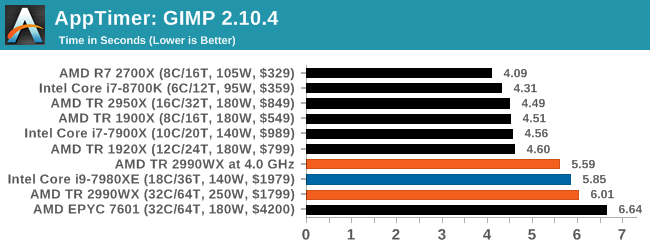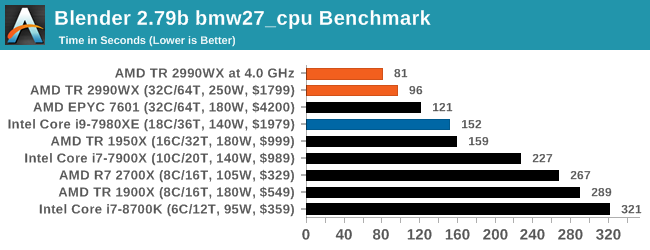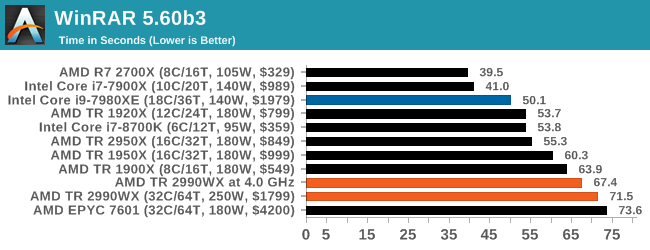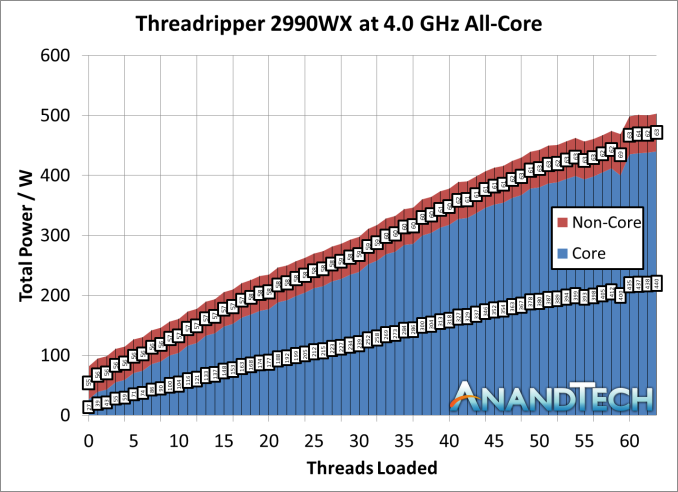The AMD Threadripper 2990WX 32-Core and 2950X 16-Core Review
by Dr. Ian Cutress on August 13, 2018 9:00 AM ESTOverclocking: 4.0 GHz for 500W
Who said that a 250W processor should not be overclocked? AMD prides itself as being a processor manufacturer that offers every consumer processor as a multiplier unlocked part, as well as using a soldered thermal interface material to assist with thermal dissipation performance. This 2990WX has an X in the same, so let the overclocking begin!
Actually, confession time. We did not have much time to do overclocking by any stretch. This processor has a 3.0 GHz base frequency and a 4.2 GHz turbo frequency, and in an air-conditioned room using the 500W Enermax Liqtech cooler, when running all cores under POV-Ray, we observed each core running around 3150 MHz, which is barely above the turbo frequency. The first thing I did was set the all-core turbo to 4.2 GHz, the same as the single core turbo frequency. That was a bust.
However, the next stage of my overclocking escapades surprised me. I set the CPU to a 40x multiplier in the BIOS, for 4.0 GHz on all the cores, all the time. I did not adjust the voltage, it was kept at auto, and I was leaving the ASUS motherboard to figure it out. Lo and behold, it performed flawlessly through our testing suite at 4.0 GHz. I was shocked.
All I did for this overclock was turn a setting from ‘auto’ to ‘40’, and it breezed through almost every test I threw at it. I say almost every test – our Prime95 power testing failed. But our POV-Ray power testing, which draws more power, worked. Every benchmark in the suite worked. Thermals were high (in the 70s), but the cooler could take it, and with good reason too.
At full load in our POV-Ray test, the processor was listed as consuming 500W. The cooler is rated for 500W. At one point we saw 511W. This was split between 440W for the cores (or 13.8W per core) and 63W for the non-core (IF, IO, IMC) which equates to only 12.5% of the full power consumption. It answers the question from our Infinity Fabric power page - if you want the interconnect to be less of the overall power draw, overclock!
We also tried 4.1 GHz, and that seemed to work as well, although we did not get a full benchmark run out of it before having to pack the system up. As stated above, 4.2 GHz was a no-go, even when increasing the voltage. With tweaking (and the right cooling), it could be possible. For anyone wanting to push here, chilled water might be the way to go.
Performance at 4.0 GHz
So if the all-core frequency was 3125 MHz, an overclock to 4000 MHz all-core should give a 28% performance increase, right? Here are some of the key tests from our suite.






Overclocking the 2990WX is a mixed bag, because of how it does really well in some tests, and how it still sits behind the 2950X in others due to the bi-modal nature of the cores. In the tests were it already wins, it pushes out a lot more: Blender is up 19% in throughput, POV-Ray is up 19%, 3DPM is up 19%. The other tests, is catches back up to the 2950X (Photoscan), or still lags behind (app loading, WinRAR).
Overclocking is not the cure-all for the performance issues on the 2990WX, but it certainly does help.











171 Comments
View All Comments
Ian Cutress - Monday, August 13, 2018 - link
It looks like the 2950X are reversed (C++ should be OpenCL), but I checked the raw data and that's what came out of the benchmark. I need to put the 2950X back on to test, I'll do it in a bitStuka87 - Monday, August 13, 2018 - link
Thanks for getting this up Ian! An awesome read per usual :)deathBOB - Monday, August 13, 2018 - link
The interconnect analysis was very interesting, glad you spent time on that.mapesdhs - Monday, August 13, 2018 - link
Yes, that was good. I had flashbacks to reading SGI Origin technical reports 20 years ago. :Dhttp://www.sgidepot.co.uk/origin/isca.pdf
http://www.sgidepot.co.uk/origin/hypercube.pdf
Index: http://www.sgidepot.co.uk/origin/
I see a great many similarities, though the emphasis is different (SGI was all about bandwidth rather than latency, for extreme I/O and huge datasets in shared memory, though they greatly improved the latency behaviour with the 2nd-gen design). Fascinating to see many of the same issues play out in the consumer space, but for rather different tasks, though I bet a lot of researchers in industry and academia will be taking keen interest in what AMD has released.
close - Monday, August 13, 2018 - link
"They will enable four cores per complex (8+8+8+8) and three cores per complex (6+6+6+6)"3/4 cores per complex or 6/8 cores?
MrSpadge - Monday, August 13, 2018 - link
The 8 cores per die are distributed over 2 CCX core complexes with 4 cores each, as in Ryzen 1.FreckledTrout - Monday, August 13, 2018 - link
LOL You actually ran tests with the plastic on? That is just funny. Did the plastic melt?Ian Cutress - Monday, August 13, 2018 - link
It ran fine, though the numbers suggest the thermals reduced PB2/XFR2 turbo by a fair bit. Some tests look a bit down. Still writing it up :)FreckledTrout - Tuesday, August 14, 2018 - link
Hilarious. That does sound like something I would do in a hurry. I see you have a whole section awaiting for plastic vs no plastic thermals. I bet that will be an Anandtech only talking point. :)msroadkill612 - Thursday, August 16, 2018 - link
A coredom?